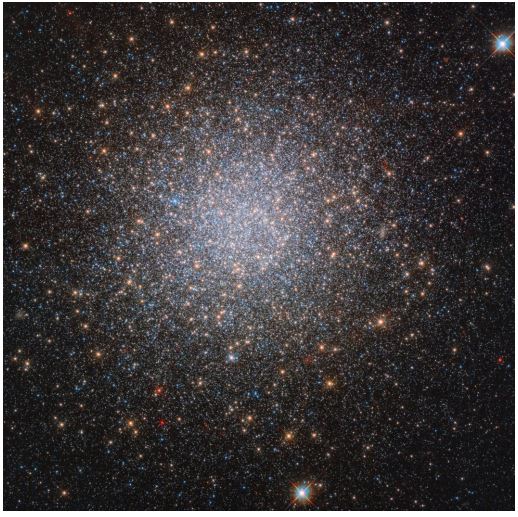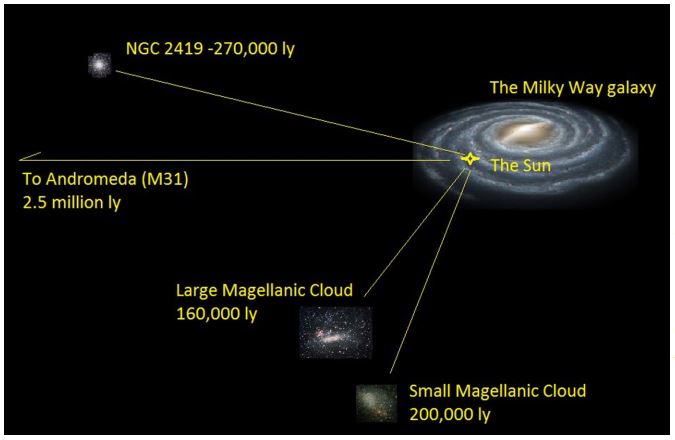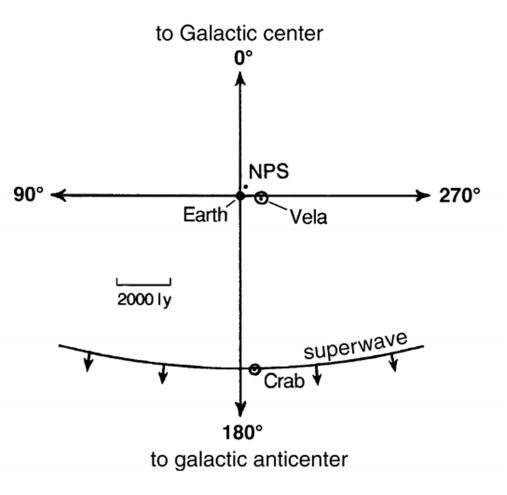© 2020 Tom Allen
© 2020 The Urantia Book Fellowship
| TODAY is the day for JOY! | Volume 20, Number 1, 2020 (Summer) — Index | To Beget Or Not to Beget That Is the Question |
The Urantia papers reveal that each of the seven superuniverses has a major purpose in the expression of its totality. The major purpose of tardy Orvonton is the bestowal of lavish mercy upon us all. [UB 15:14.2-3] Because this bountiful conferral of love and mercy encompasses the “meaning-of-the-whole,” God the Supreme is likely, in the distant future, to wield Her completed personal and sovereign Almighty power as the Supreme Being from Uversa. This makes Uversa a very special place in the grand universe.
The Urantia papers give rise to a credible hypothesis about the location of Uversa when coupled with current astronomy and historic considerations. Recent research on the distant globular cluster NGC 2419 reveals certain possibilities that the “Intergalactic Wanderer” is the greater system wherein Uversa is located in the constellation Lynx.
Because it seemed so distant, Harlow Shapley in 1922 called NGC 2419 the “Intergalactic Tramp,” meaning that it seemed to be tramping across the universe with no connection to the Milky Way. It is now commonly nicknamed the “Intergalactic Wanderer” to clarify what Shapley meant.

In order to justify the hypothesis that NGC 2419 is the location of Uversa, here are pertinent historical and current facts used to find a universe framework for comparative analysis and synthesis with the Urantia papers:
- It was discovered by William Herschel on December 31, 1788.
- It is estimated to contain a million stars across a spatial diameter of 400 light-years.
- NGC 2419 is in the direction very near the galactic anticenter toward Lynx. This line begins at the center of the Milky Way and goes through Urantia (and Jerusem) and follows this particular direction through the dense diameter of the Milky Way toward Lynx.
- It is one of the brightest, largest, and most distant globular clusters surrounding the Milky Way.
- Harlow Shapley estimated the distance to NGC 2419 in 1922 at 168,000 light-years.[1]
- Walter Baade estimated the distance in 1935 at 185,000 light-years.[2]
- The radial velocity is 20 km/sec in our direction.[3]
- It takes three billion years for NGC 2419 elliptically to rotate once over the pole of the Milky Way.[4]
- NGC 2419 contains two separate populations of red giant stars, one of which is unusually helium-rich. These stars are rotating predominantly in the center of NGC 2419.[5]
- The present distance estimate from Urantia to NGC 2419 is approximately 270,000 light-years.
- The furthest distance in the rotation of NGC 2419 around the Milky Way from Urantia is 319,000 light-years.
- The closest approach of NGC 2419 to Urantia is 172,000 light-years.
- The average distance of NGC 2419 from Urantia is 245,000 light-years.

The following four quotes are all the references in the Urantia papers about the location of Uversa. Each quote is followed with analysis about how NGC 2419 correlates with evidence concerning the location of Uversa.
The Sagittarius sector and all other sectors and divisions of Orvonton are in rotation around Uversa, and some of the confusion of Urantian star observers arises out of the illusions and relative distortions produced by the following multiple revolutionary movements: [UB 15:3.7]
The whirl of the ten major sectors, the so-called star drifts, about the Uversa headquarters of Orvonton. [UB 15:3.13]
Analysis of English usage is critical to decipher what the revelators mean when describing cosmology. As a noun in Webster’s 1934 dictionary, “whirl” means rapid rotation, gyration, or circumvolution. In complicated English, the word “about” can be used as a prepositional phrase functioning as an adverb. This means that “about” translates to “in or somewhat near.” Example: I ride my bicycle about my neighborhood. This is the same way “about” is used in [UB 15:3.13]. All ten major sectors within the Milky Way are in rotation “around” Uversa. “Around” is also used as a preposition and is defined in its second definition from Webster’s 1934 dictionary as, “Here and there in the vicinity of, so as to lie on every side; also, into proximity of or toward, from all directions; as the trees around his grave.” This may be the way the Universal Censor meant to define “around.” Major sectors rotate around Uversa and NGC 2419.
It is clear that the Milky Way is in rotation.[6] This rotation is the Milky Way “whirl” along with the whirl of the ten major sectors within the Milky Way. NGC 2419 orbits over the pole of the Milky Way every three billion years. Thus, the Milky Way and the ten major sectors all whirl around multiple times for each polar rotation of NGC 2419. This hypothetically means that these ten Orvonton major sector so- called star drifts rotate and “whirl” “around” and “about” Uversa — NGC 2419.
- While each superuniverse government presides near the center of the evolutionary universes of its space segment,… While sharing the light of near-by suns,… These headquarters worlds belong to one of the greater systems situated near the astronomical center of their respective superuniverses. [UB 15:7.1]
Barycenter is an astronomical term to denote the specific location of the common center of mass around which two or more bodies revolve. For example, the barycenter of the Milky Way is situated in an immense black hole or a massive dark island of space estimated to be the mass of four million suns named Sagittarius A*. (Sag A*) Another example is that the barycenter of Monmatia (our solar system) is centered in our sun.
Uversa is over 200,000 light-years from Jerusem, and is “near” or close to the astronomical center of the seventh superuniverse space segment. If NGC 2419 is being identified as the astronomical center because of its power control, then NGC 2419 being near the center, could itself be the barycenter of the entire space segment of the seventh superuniverse. However, the physical or astronomical barycenter could be somewhere else nearby, such as the center of the Milky Way or another undisclosed nearby location. Uversa is still “near” wherever is located the barycenter of “its space segment.” This seventh space segment possibly involves many more uninhabited galaxies from the local group, the local sheet, or the local volume along with the partially and solely inhabited Milky Way. Speculatively, they will all architecturally conjoin with the evolving Milky Way in possibly trillions of Urantia years. That is possibly how long we must wait for the completion of Supremacy.
Regardless of what the revelators meant by the true physical and astronomic center of the seventh superuniverse, it is non-consequential to the theory that NGC 2419 is the location of Uversa.
NGC 2419 is clearly “one of the greater systems” surrounding the Milky Way. NGC 2419 can provide many nearby suns for Uversa. If Uversa is located on the periphery of NGC 2419 and if it is being referred to as the astronomical center, then Uversa would be near to that center and free from the unwanted influence of gigantic living or dead suns.
- . . . Uversa is favorably situated for the work of this colony, not only because of its central location, but also because there are no gigantic living or dead suns near at hand to disturb the energy currents. [UB 30:3.2]
Uversa within NGC 2419 has a central location near the astronomical center of the entire seventh superuniverse space segment. Uversa is the nucleus of electronic power regulation for the entire space segment of Orvonton. Two populations of rotating red giant stars rotate around the center of NGC 2419, so Uversa with its central location could have been constructed outside of the center of NGC 2419. Uversa could be situated in the periphery of the cluster in a central location of its space segment. It could easily share the light with near-by suns.
The Satania system of inhabited worlds is far removed from Uversa and that great sun cluster which functions as the physical or astronomic center of the seventh superuniverse. From Jerusem, the headquarters of Satania, it is over two hundred thousand light-years to the physical center of the superuniverse of Orvonton, far, far away in the dense diameter of the Milky Way. Satania is on the periphery of the local universe, and Nebadon is now well out towards the edge of Orvonton. From the outermost system of inhabited worlds to the center of the superuniverse is a trifle less than two hundred and fifty thousand light- years. (UB 32:2.11)

In this quote, Uversa seems to be identified as “the physical and astronomic center of the seventh superuniverse.” From this astronomical center, power is regulated by one thousand power centers of the third order. [UB 15:8.1-2] [UB 29:2.13-15] Immense electronic power is partially controlled from Uversa and bathes the entire seventh space segment. This is what possibly makes Uversa “the physical and astronomic center of the seventh superuniverse.” In this quote, the barycenter is not being identified, although arguments can be made that Uversa is “near” the ambiguous barycenter.**
It is likely that our superuniverse is gravitationally barycentric at some unrevealed place in the vast space segment of Orvonton. Identification of the physical and astronomic barycenter of Orvonton is a worthy study not relevant to the hypothetical conclusion that NGC 2419 is the location of Uversa, and near to whichever center is being postulated.
“In” is a common astronomic term that indicates direction. “In the dense diameter of the Milky Way” refers to the direction through the density of the flat plane of the Milky Way. There are conceptually an infinite number of dense diameters within the Milky Way. This particular anticenter direction is a line through the dense diameter from the galactic center toward nearby Lynx and NGC 2419. The Milky Way is quite dense in this direction as opposed to a direction above or below the Milky Way.
The “outermost system” is probably in Nebadon because the prior sentence references Nebadon. Thus, the outermost system in Nebadon is a trifle less than 250,000 light-years from Uversa. The average distance of NGC 2419 from Jerusem is approximately 245,000 light-years. A comparison of the average distance of a nearby and outermost Nebadon system to the average distance of Jerusem to Uversa, puts these two systems only a few thousand light-years apart. This could be true if the revelators plausibly meant to average the distances of these two Nebadon systems from Uversa.
In conclusion of this hypothesis, these following data and speculations give strong evidence to justify the conclusion that NGC 2419 is possibly the location of Uversa. This theory is based on the concept that “over two hundred thousand light-years” is literal and not an analogy.
- Uversa is located “in the dense diameter” which means that it is in the direction of the anticenter through Urantia which is through the medium of the density of the Milky Way toward Lynx and NGC 2419. The distance from Urantia to Jerusem does not significantly change this direction.
- “That great sun cluster” NGC 2419 is posited to be either the barycenter of the seventh space segment, the astronomical center of power control, or both. Any interpretation of the location of “the physical and astronomic center” is compatible with NGC 2419 as the home of Uversa.
- 245,000 light years is the average distance from Urantia to Uversa. This is consistent with the revealed distance to Uversa from Jerusem which is over 200,000 light-years. One plausible reason the revelators could not reveal the actual distance to NGC 2419 by 1934, is because Shapley and Baade measured it at less than 200,000 light-years. Knowing that modern science would eventually discover a truer distance to NGC 2419, the only clue the revelators were willing to give was that its distance is over 200,000 light-years.
- A trifle less than 250,000 light-years is the average distance of the “outermost system” in Nebadon to Uversa. Satania’s average distance from NGC 2419 of 245,000 light-years could be just a few thousand light-years apart from this furthest away Nebadon outermost system.
The ten major sector Milky Way so-called star drifts whirl elliptically around and about the three billion light-year orbit of NGC 2419 over, and around the Milky Way.
I am eager to see if others can come up with a better location for Uversa. Feel free to discourse with me at tommykaren1@gmail.com. It seems that the revelators expected us to find the location of Uversa with these vague clues about its whereabouts.
In the meantime, let us enjoy all the love and mercy lavishly bestowed upon us and spread this beneficence to all, as we progress in the glory of our universe ascent as sons and daughters of a living and loving Father God and a Supreme Mother. [UB 117:6.2]
When the grand universe is in light and life, the maximum finite completion of our divine Mother — the Supreme Being — will likely reign in loving power-personality synthesis from Uversa. NGC 2419 could very well eventually be Her finite home.
Tom has been a believer in the teachings of the Urantia papers since 1973. He lives in Oklahoma City and is an adjunct professor of nursing at Oklahoma City University. As a philosopher, cosmology is a passion. He has published a book entitled The Great Debate on the Location of Orvonton available on Amazon.com, and has a Vimeo on this great debate at: https://vimeo.com/343356366. Tom gave a talk on this topic at the Scientific Symposium II sponsored in the fall of 2019 by Urantia Foundation. This is available in English at the video below. A French translation is available upon request. tommykaren1@gmail.com
https://www.youtube.com/watch?v=Pv42QFIAxaI
¶ References
- Article obtained from The Fellowship site
| TODAY is the day for JOY! | Volume 20, Number 1, 2020 (Summer) — Index | To Beget Or Not to Beget That Is the Question |
¶ Notes
Shapley, Harlow (10/1922) Harvard College Observatory Bulletin No. 776, pp.4-5 ↩︎
Baade, W (12/1935) The Globular Cluster NGC Astrophysical Journal, 82, 396- 412 DOI: http://adsabs.harvard.edu/doi/10.1086/143687 Ibid, p 397 ↩︎
Massar, D., Posti, L., Helm, A., Fiorenti, G., & Tolstoi, E. (February 2017) Astronomy and Astrophysics, The Power of Teaming up HST and Gaia: The First Proper Motion Measurement of the Distant Cluster NGC 2419, 598 (Id.L9), https://doi.org/10.1051/0004-6361/201630174 ↩︎
Gerhardt R Meurer, Danail Obreschkow, O Ivy Wong, Zheng Zheng, Fiona M Audcent-Ross, D J Hanish, Cosmic clocks: a tight radius–velocity relationship for H I-selected galaxies, Monthly Notices of the Royal Astronomical Society, Volume 476, Issue 2, May 2018, Pages 1624 – 1636, https://doi.org/10.1093/mnras/sty275 ↩︎